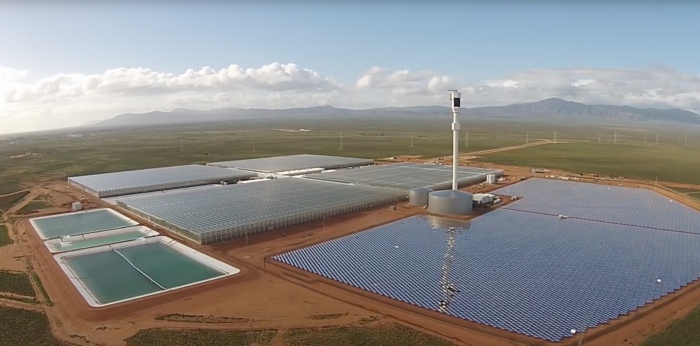A Desert Full of Tomatoes, Thanks to Solar Power and Seawater
At first glance, growing fruit in the desert sounds like an awfully good way to feed a mushrooming global population and adapt to the worst effects of climate change. And a farm in South Australia run by the greenhouse developer Sundrop Farms is doing just that, using solar power to desalinate water and grow tomatoes in the otherwise parched landscape.
Farmers Weekly reports that the $150 million facility focuses sunlight from 23,000 mirrors onto a tower to produce energy that drives an attached desalination system. Sucking water from the nearby Spencer Gulf, it produces up to one million liters of fresh water every day.
The result is tomatoes—lots of tomatoes. The farm fills eight trucks every day with greenhouse-raised tomatoes, and it’s expected to produce more than 15,000 tons of the things per year when it reaches full capacity.

But while it’s certainly an impressive feat, there is an argument that says there’s simply not much point using solar energy production facilities like this to grow fruit and vegetables. Talking to New Scientist, Paul Kristiansen from the University of New England in Australia said that it was “a bit like crushing a garlic clove with a sledgehammer.” He added, “We don’t have problems growing tomatoes in Australia.”
He has a point. Desalination is on the rise in many areas of the world, but it is mostly done through reverse osmosis, an expensive and energy-intensive process. As a result, desalination plants really only make sense in places that are water-stressed and have the resources necessary to build, run, and maintain them.
That may change as cheaper techniques become more robust and fresh water supplies dwindle in some places as a result of climate change. Even then, though, this isn’t a technology that’s likely to catch on in poorer regions—which, unfortunately, are also the most likely to have a hard time adapting to shifting climate patterns. Solving that problem is likely to be a matter not of sheltering plants in greenhouses, but of designing crops that really can survive in a desert.
(Read more: Farmers Weekly, New Scientist, “To Make Fresh Water without Warming the Planet, Countries Eye Solar Power,” “10 Breakthrough Technologies 2015: Megascale Desalination”)
Keep Reading
Most Popular
Large language models can do jaw-dropping things. But nobody knows exactly why.
And that's a problem. Figuring it out is one of the biggest scientific puzzles of our time and a crucial step towards controlling more powerful future models.
How scientists traced a mysterious covid case back to six toilets
When wastewater surveillance turns into a hunt for a single infected individual, the ethics get tricky.
The problem with plug-in hybrids? Their drivers.
Plug-in hybrids are often sold as a transition to EVs, but new data from Europe shows we’re still underestimating the emissions they produce.
Stay connected
Get the latest updates from
MIT Technology Review
Discover special offers, top stories, upcoming events, and more.